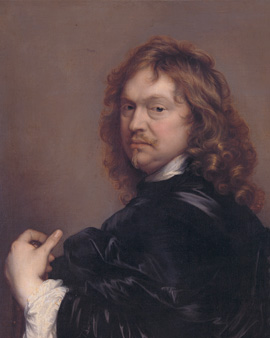Adriaen Hanneman was born around 1603 in The Hague in the Netherlands and came from a wealthy Catholic patrician family. He received his first training in drawing in his hometown under the guidance of Jan Anthonisz. van Ravesteyn. In 1623, at the age of about twenty, Hanneman took the big step and moved to England. He stayed there for 16 years and grew into a respected portrait painter. His skills and style made him a sought-after artist, especially for portraits of the royal family. While in England, he was able to collaborate with and learn from some of the most famous artists of the time, including Anthony van Dyck, Cornelis Janssens van Ceulen, and Daniel Mytens.
After returning to The Hague in 1640, Hanneman married Maria van Ravesteyn, the daughter of his former teacher. Upon his return, he also took an active role in the local artistic community. In 1645, he was elected president of the Guild of St. Luke in The Hague, a prestigious position that further enhanced his standing in the artistic community. But in 1656, a rift occurred: Hanneman and several other members left the Guild of St. Luke and founded their own artists' association, the Confrérie Pictura. Their intention was to create a new artistic movement that would stand apart from established norms. In recognition of his contributions to the new association, Hanneman was awarded a silver cup in 1666.
Hanneman was not only an outstanding painter, but also an influential teacher. Among his students were Jeremias van der Eyden and Reinier de la Haye. His style also had a lasting influence on the painter Govaert Flinck. After the death of his first wife in 1669, Hanneman married Alida Bezemer. However, in the years leading up to the Rampjaar, a year of disasters in the Netherlands, Hanneman ran into financial difficulties, as did many Catholic painters at the time. This led to numerous disposals of assets in 1670. At his death in 1671, he left all his drawings and engravings to his pupil Simon du Parcq.
Despite the financial difficulties Hanneman experienced in his final years, his artistic legacy remains undisputed. Today, his works in the form of art prints continue to be appreciated and collected by art lovers around the world, helping to keep alive his artistic contributions and influence on succeeding generations of artists. At his death, he left an estate that yielded only a sum of 1000 guilders, but the true value of Hanneman's legacy cannot be measured in money. It lives on in his paintings, which are still on display in museums and galleries around the world, and in the art prints that bring his art to people, regardless of time or place. Adriaen Hanneman may have passed away physically, but his artistic presence remains and continues to shape the art world. His unique interpretation of portraits and richness of detail continue to inspire young artists and art lovers today.
×





.jpg)
.jpg)
.jpg)
.jpg)
.jpg)
.jpg)
_-_(MeisterDrucke-1645710).jpg)
_-_(MeisterDrucke-1645710).jpg)
_-_(MeisterDrucke-1430359).jpg)
_-_(MeisterDrucke-1430359).jpg)
_-_(MeisterDrucke-1430149).jpg)
_-_(MeisterDrucke-1430149).jpg)
.jpg)
.jpg)
_2nd_Lord_Culpeper_-_(MeisterDrucke-283569).jpg)
_2nd_Lord_Culpeper_-_(MeisterDrucke-283569).jpg)
_c1605-63_(oil_-_(MeisterDrucke-1376875).jpg)
_c1605-63_(oil_-_(MeisterDrucke-1376875).jpg)
.jpg)
.jpg)
_Countess_of_Carlisle_c1660-65_(oil_on_canvas)_-_(MeisterDrucke-906764).jpg)
_Countess_of_Carlisle_c1660-65_(oil_on_canvas)_-_(MeisterDrucke-906764).jpg)
_-_(MeisterDrucke-979784).jpg)
_-_(MeisterDrucke-979784).jpg)
_with_a_Servant_c1664_-_(MeisterDrucke-635383).jpg)
_with_a_Servant_c1664_-_(MeisterDrucke-635383).jpg)
.jpg)
.jpg)
 Countess of Carlisle (1599 - (MeisterDrucke-543294).jpg)
 Countess of Carlisle (1599 - (MeisterDrucke-543294).jpg)
.jpg)
.jpg)
.jpg)
.jpg)
.jpg)
.jpg)
.jpg)
.jpg)
_-_(MeisterDrucke-1520079).jpg)
_-_(MeisterDrucke-1520079).jpg)
.jpg)
.jpg)
_-_(MeisterDrucke-1570862).jpg)
_-_(MeisterDrucke-1570862).jpg)
_daughter_of_2nd_Lord_Colepeper_-_(MeisterDrucke-216441).jpg)
_daughter_of_2nd_Lord_Colepeper_-_(MeisterDrucke-216441).jpg)
.jpg)
.jpg)
.jpg)
.jpg)
_Prince_of_Orange_as_a_Child_-_(MeisterDrucke-1392569).jpg)
_Prince_of_Orange_as_a_Child_-_(MeisterDrucke-1392569).jpg)
.jpg)
.jpg)
.jpg)
.jpg)
_Hendrik_Casimir_I_-_(MeisterDrucke-1563492).jpg)
_Hendrik_Casimir_I_-_(MeisterDrucke-1563492).jpg)
_wife_of_2nd_Lord_Colepeper_(oil_on_canvas)_-_(MeisterDrucke-1130044).jpg)
_wife_of_2nd_Lord_Colepeper_(oil_on_canvas)_-_(MeisterDrucke-1130044).jpg)
.jpg)
.jpg)
_-_(MeisterDrucke-1430358).jpg)
_-_(MeisterDrucke-1430358).jpg)
.jpg)
.jpg)
.jpg)
.jpg)
.jpg)
.jpg)
.jpg)
.jpg)
.jpg)
.jpg)
_-_(MeisterDrucke-937081).jpg)
_-_(MeisterDrucke-937081).jpg)
.jpg)
.jpg)
.jpg)
.jpg)
_Peinture_de_Adriaen_Hannemann_(Adrien_Han_-_(MeisterDrucke-1325981).jpg)
_Peinture_de_Adriaen_Hannemann_(Adrien_Han_-_(MeisterDrucke-1325981).jpg)
_Lord_of_Sommelsdijk_Colonel_of_Cavalry_-_(MeisterDrucke-1392187).jpg)
_Lord_of_Sommelsdijk_Colonel_of_Cavalry_-_(MeisterDrucke-1392187).jpg)
.jpg)
.jpg)
_and_his_Five_Children_-_(MeisterDrucke-1570858).jpg)
_and_his_Five_Children_-_(MeisterDrucke-1570858).jpg)






